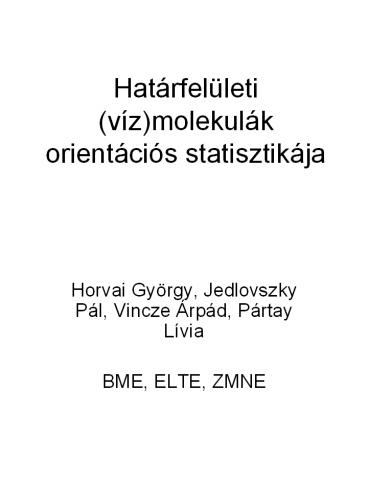Hat - PowerPoint PPT Presentation
Title:
Hat
Description:
Hat rfel leti (v z)molekul k orient ci s statisztik ja ... Zhang et al., JCP 103 (1995) 10252, octane. Fernandes et al., JPC/B 103 (1999) 6290 2-heptanone ... – PowerPoint PPT presentation
Number of Views:25
Avg rating:3.0/5.0
Title: Hat
1
Határfelületi (víz)molekulák orientációs
statisztikája
- Horvai György, Jedlovszky Pál, Vincze Árpád,
Pártay Lívia - BME, ELTE, ZMNE
2
OVERVIEW OF PREVIOUS STUDIES
i.) No particular orientational
preference Carpenter, Hehre, JPC 94 (1990) 531
hexane
- ii.) Dipole of water molecules located
- closest to the apolar phase points toward
- the apolar phase
- farther from the apolar phase points toward
- the aqueous phase
- van Buuren et al., JPC 97 (1993) 9206 decane
iii.) Dipole of water molecules is parallel with
the interface Linse, JCP 86 (1987) 417,
benzene Benjamin, JCP 97
(1992) 1432 1,2-dichloroethane
- iv.) Dipole of water molecules is almost parallel
with the - interface, however, it deviates from
parallel alignment - toward the apolar rather than the aqueous
- phase for waters located closest to
- the apolar phase
- toward the aqueous rather than the apolar
- phase for waters located farther from the
- apolar phase
- Zhang et al., JCP 103 (1995) 10252,
octane - Fernandes et al., JPC/B 103 (1999) 6290
2-heptanone
3
v.) The H-H vector of the water molecules
located closest to the interface is
perpendicular to the interface Benjamin,
JCP 97 (1992) 1432 1,2-dichloroethane
Chang and Dang, JCP 104 (1996) 6772
CCl4 Vincze et al., Anal. Sci. 17 (2001) i317
1,2-dichloroethane
vi.) The H-H vector of the water molecules
located farther from the interface has no
particular orientational
preference Benjamin, JCP 97 (1992) 1432
1,2-dichloroethane
vii.) The H-H vector of the water molecules
located farther from the interface is
parallel with the interface Chang and Dang, JCP
104 (1996) 6772 CCl4
4
Orientation of water at the air/water interface
5
Concept of the bivariate joint distributions
The interfacial orientation of the molecules can
be analyzed at different levels of statistics
1. Level of the orientational profiles of various
orientational parameters Average of parameters
describing the orientation of various,
molecule-fixed vectors relative to the interface
irrespective the other vectors Profiles along
the interface normal
2. Level of monovariate distributions of the
individual orientational parameters Distribution
of these parameters in separate water layers
along the interface normal
3. Level of bivariate distribution of two
independent orientational parameters Joint
distribution of two independent orientational
parameters in separate water layers along the
interface normal. (One to one mapping of
orientation on the parameters not sufficient.
Distribution in bulk should be uniform!)
6
Orientációs eloszlási térképek a felszínközeli
rétegekben
X
II
I
7
X
I
II
8
Dependence of the results on the apolar phase
9
Dependence of the results on the aqueous phase
Liquid/vapor interface of water-methanol mixtures
WATER ORIENTATION MAPS
10
DENSITY PROFILES
11
Non-equilibrium dynamics and structure of
interfacial ice Oliviero Andreussi, Davide
Donadio, Michele Parrinello, Ahmed H.
Zewail Chemical Physics Letters 2006 Figure
4 Orientational probability distribution P(cos ?,
f) for the three regions of three bilayer thick
interfacial ice. The two independent
orientational parameters (?, f) are the angular
polar coordinates of the vector normal to the
substrate's surface, in a coordinate frame fixed
to the individual water molecules 34. The
presence of four preferred orientations is
evident for the crystalline systems (below 180
K). At higher temperatures systems present
orientational disorder in the bulk region, while
molecules at the free surface tend to point
towards the inner layers and a more structured
bilayer is present at the ice-substrate interface































